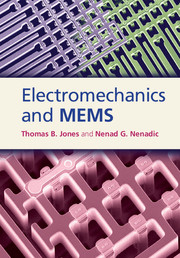Book contents
- Frontmatter
- Contents
- Preface
- 1 Introduction
- 2 Circuit-based modeling
- 3 Capacitive lumped parameter electromechanics
- 4 Small-signal capacitive electromechanical systems
- 5 Capacitive sensing and resonant drive circuits
- 6 Distributed 1-D and 2-D capacitive electromechanical structures
- 7 Practical MEMS devices
- 8 Electromechanics of piezoelectric elements
- 9 Electromechanics of magnetic MEMS devices
- Appendix A Review of quasistatic electromagnetics
- Appendix B Review of mechanical resonators
- Appendix C Micromachining
- Appendix D A brief review of solid mechanics
- Index
- References
3 - Capacitive lumped parameter electromechanics
Published online by Cambridge University Press: 05 May 2013
- Frontmatter
- Contents
- Preface
- 1 Introduction
- 2 Circuit-based modeling
- 3 Capacitive lumped parameter electromechanics
- 4 Small-signal capacitive electromechanical systems
- 5 Capacitive sensing and resonant drive circuits
- 6 Distributed 1-D and 2-D capacitive electromechanical structures
- 7 Practical MEMS devices
- 8 Electromechanics of piezoelectric elements
- 9 Electromechanics of magnetic MEMS devices
- Appendix A Review of quasistatic electromagnetics
- Appendix B Review of mechanical resonators
- Appendix C Micromachining
- Appendix D A brief review of solid mechanics
- Index
- References
Summary
Basic assumptions and concepts
In Chapter 1, we introduced the notion of the lossless electromechanical coupling. Then, in Chapter 2, the principles and approximations of circuit-based device modeling were reviewed. The primary goal of Chapter 3 is to introduce the energy-based technique for determining the electrical force operative in a capacitive transducer. This force effects the electromechanical transduction of energy between electrical and mechanical forms, and we cannot predict the behavior of a MEMS device without it. Electromechanical interactions in capacitive devices arise from either of two physical origins. First and far more familiar is the Coulombic interaction of electric charges at a distance. The force exerted on an electrostatic charge q is qE̅, where E̅, the vector electric field, is the superposition of the force fields created by all the other charges. The other, less well-known force mechanism originates from the interactions of an electric field with the dipoles that constitute liquids and solids. These dipoles can be either induced or permanent. The essential requirement for an observable force is a non-uniform electric field. All dipoles have zero net charge, but if the positive and negative charge centers experience slightly different electric field vectors, there will be a net force. For a small dipole having moment p̅, this force may be approximately expressed by p̅·∇E̅. An ensemble of dipoles in any solid (or liquid) can experience a net body force, called the ponderomotive effect. The classic book by Landau and Lifshitz presents a general electroquasistatic formulation for the volume density of the ponderomotive force [1].
Information
- Type
- Chapter
- Information
- Electromechanics and MEMS , pp. 44 - 96Publisher: Cambridge University PressPrint publication year: 2013
